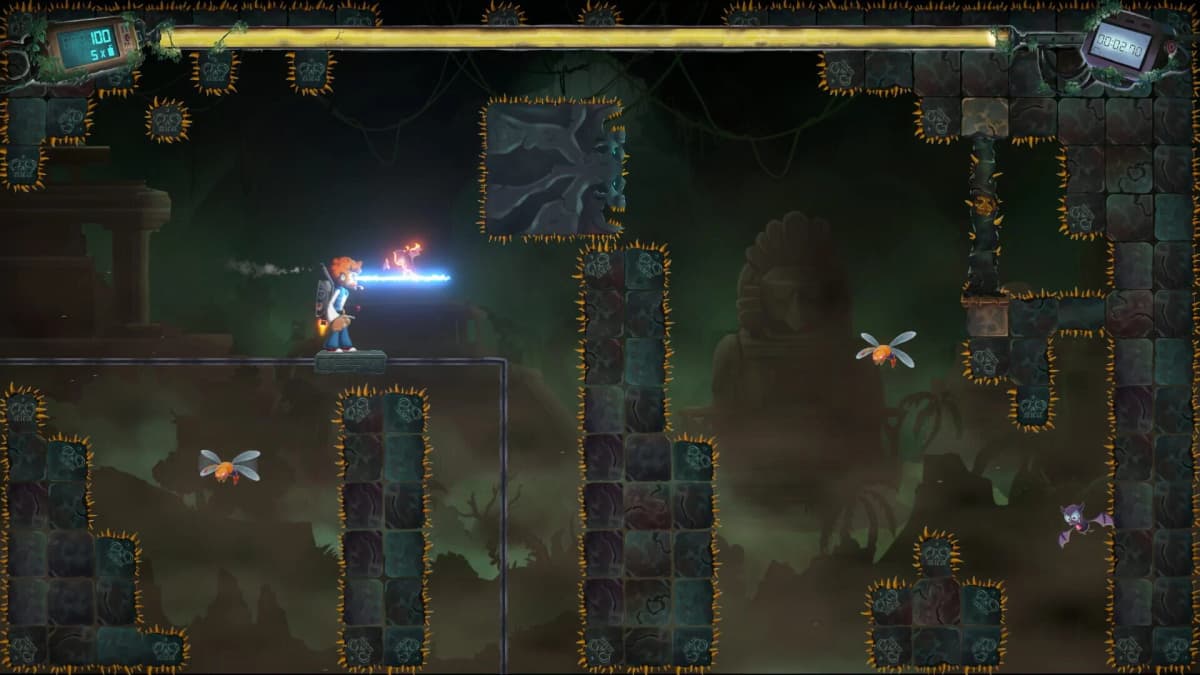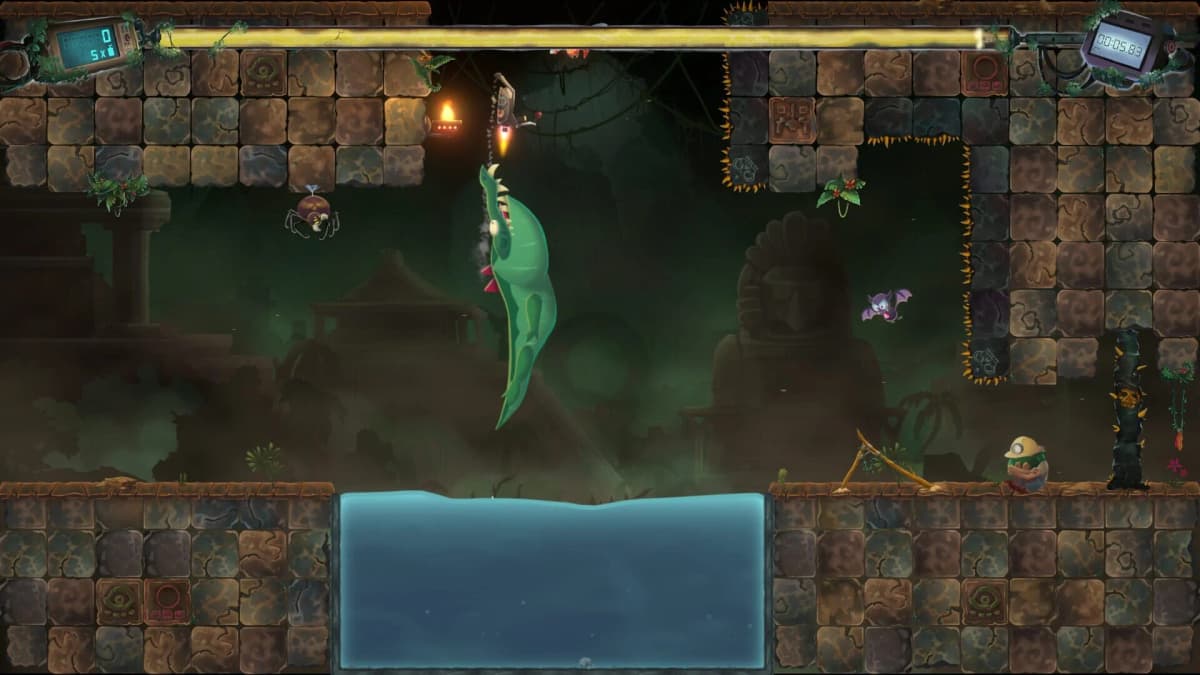
Game intel
Klaus Lee – Thunderballs
Dive deep through the neon-hued brash and bawdy '80s inspired reimagined classic 2D action-platformer with your favorite Bad*ss German, Klaus Lee! Dust off you…
Let’s face it: the market is flooded with 80s-inspired pixel platformers, each one vying for our retro-loving hearts. Yet every so often, a title emerges that leans so unapologetically into its own absurdity you can’t help but press start. Klaus Lee – Thunderballs, available on PC and consoles for €12.99 (with launch discounts in tow), barrels across that line with moustache-fueled gusto, 100+ handcrafted levels, slow-motion nitro dives, and a user-friendly level editor. In this expanded review, we’ll dig deeper into its strengths, its stumbles, and whether its community features can transform it from a flash of neon into a lasting cult classic.
At the core of Thunderballs is a platformer that blends traditional run-and-jump precision with a bullet-time stunt system and dynamite physics. Triggering slow-motion allows Klaus Lee to pirouette through spiked traps, bounce missiles off enemy sentries, and detonate regulated explosions midair. In theory, it’s a perfect nod to 80s action flicks—think Arnie or Stallone in pixel form—but in practice the balance teeters. When the slowdown is dialed just right, sequences feel like a finely choreographed scene on VHS; when it creeps in too often, the pacing tips into tedious.
We found that a well-timed stunt sequence can spark genuine “wow” moments: dodging a fireball only to hurl it back at a flamethrower turret, or using your grappling hook to swing above a collapsing wall. Yet at times those same mechanics collide awkwardly. Slow-mo activation can feel inconsistent—press the trigger too late and you overshoot a narrow ledge; too early and you digest more pixels than precision. Some veteran platformer fans might grumble about floaty controls during these high-octane set pieces, while newcomers will delight in the cinematic flair.
With over 100 handcrafted stages, Thunderballs stares down any procedural generation skeptics. Each level emerges from NUKKLEAR’s playbook of pacing, trap placement, and hidden collectibles. Early worlds introduce the basics—timed platforms, simple chasms, basic dynamite sticks—while mid-game zones layer in lasers, shifting walls, and environmental puzzles. Complexity spikes in the final act, demanding split-second timing to thread the needle between rotating blades and explosive barrels.
While the variety of obstacles is commendable, the difficulty curve doesn’t always feel smooth. A handful of levels lean heavily on trap-y “surprise deaths” that telegraph little beyond “you’re about to die.” There’s room here for design finessing: adding brief visual cues or adjustable challenge settings could help mitigate player frustration. That said, uncovering a cleverly hidden secret room—complete with cheeky Easter eggs—remains a highlight. These little touches remind you the levels were built with care, not churned out by an algorithm.

Arguably, the crown jewel is the robust level editor. It offers a palette of terrain tiles, traps, enemies, and even camera filters to recreate your favorite 80s action sequences—or invent entirely new nightmares. Drag-and-drop snapping, undo/redo history, and quick-play testing within the toolset contribute to a surprisingly polished experience. In-editor tutorials guide you through basic platform layouts, then challenge you to script timed events or chain dynamite reactions.
But an editor is only as good as its sharing infrastructure. At launch, the in-game hub lets you browse and download featured community stages, sorted by popularity or recent uploads. However, the tagging system feels basic—no way yet to filter for “puzzle-focused” or “speedrun.” And while the devs have hinted at Steam Workshop support and cross-platform sharing, specifics remain vague. For long-term vitality, a rock-solid server backend and moderation tools will be crucial. Otherwise, even the most creative custom maps risk vanishing into a sea of uncurated content.
Visually, Thunderballs commits fully to its neon-soaked, VHS-style aesthetic. Backgrounds pulse with CRT scan lines, palette choices swing between pastel sunsets and radioactive greens, and character sprites boast exaggerated proportions—chiefly that luxuriant pixel ‘stache. It’s campy, it’s loud, and it knows it. At peak moments, you’ll feel like you’re living out a side-scroller cut from a lost 80s anime pilot.
The chiptune soundtrack underscores the madness with high-tempo drum machines, bass riffs, and occasional saxophone stabs—further cementing the decade mashup. Audio cues for jump landings, dynamite fuses, and enemy splats are satisfyingly punchy, though the mix sometimes buries dialogue snippets (short quips from Klaus Lee himself) beneath bass beats. A more dynamic audio mixer or volume sliders per category would boost accessibility.

On PC, the game ran smoothly at 60fps across a range of hardware. Animation frames hold firm even when the screen is awash in slow-mo explosions. Console builds on Switch and last-gen PlayStation/Xbox tested similarly stable, though docked Switch mode suffered occasional texture pop-ins on dense levels. We encountered no major crashes, but minor quirks appeared: level thumbnails sometimes failed to load in the community browser, or path indicators in the editor snapped out of alignment until a restart.
The UI embraces minimalism: core HUD elements—lives, dynamite count, slow-mo meter—sit unobtrusively at screen edges. Menus adopt chunky pixel fonts that are legible but aesthetic-first; an option for a system font fallback might help color-blind or dyslexic players. Controller mapping is intuitive, with prompts matching common layouts. Keyboard/mouse combos feel equally serviceable for PC vets.
Beyond the main campaign, replay value rests on speedrun leaderboards and user-generated content. Built-in challenge timers invite you to shave seconds off your best runs, and optional collect-’em-all secrets push exploration. However, the absence of in-game daily or weekly challenges leaves the grind solely in player hands. A rotating run or dev-curated map each week could inject fresh motivation.
Retro indies often hinge on post-launch cadence—bug fixes, seasonal events, editor expansions, and community spotlights. Assemble Entertainment’s track record suggests moderate ongoing support, but specifics for Thunderballs remain under wraps. We’d welcome a roadmap outlining upcoming features: expanded editor objects, leaderboard filters, perhaps even co-op editing or PvP race modes. Until then, the game shines brightest in its early weeks of novelty; sustaining that glow will depend on developer follow-through and fan enthusiasm.

For platformer aficionados with a soft spot for 80s action pastiche, Klaus Lee – Thunderballs punches above its price tag. Its handcrafted levels deliver moments of genuine spectacle, and the editor hints at boundless creative potential. Yet the game’s reliance on slow-mo spectacle, occasional difficulty spikes, and unproven community tools keep it from feeling bullet-proof.
If you crave fast-paced pixel stunts and intend to dive headfirst into level creation or community jams, you’ll find plenty to celebrate—especially at the discounted launch price. Conversely, players seeking rigorous, pixel-perfect precision platforming or a self-sustaining post-launch ecosystem might prefer waiting for the next wave of updates.
Klaus Lee – Thunderballs ambles through 100+ handcrafted levels, slow-mo dynamite stunts, and a surprisingly deep level editor. Its 80s blood-pumping style is undeniable, but long-term success hinges on robust sharing tools, post-launch support, and smoothing out balance stumbles. Worth a spin for retro fans and aspiring creators alike—just keep an eye on that community hub.
Get access to exclusive strategies, hidden tips, and pro-level insights that we don't share publicly.
Ultimate Gaming Strategy Guide + Weekly Pro Tips